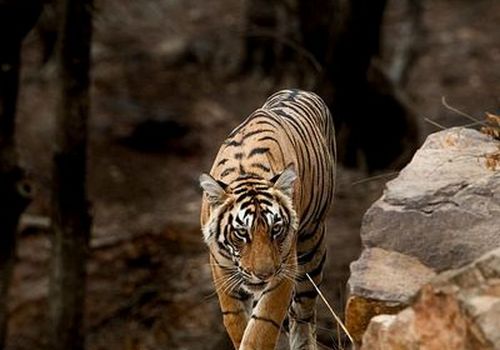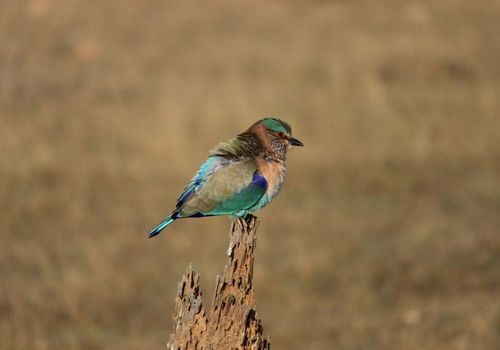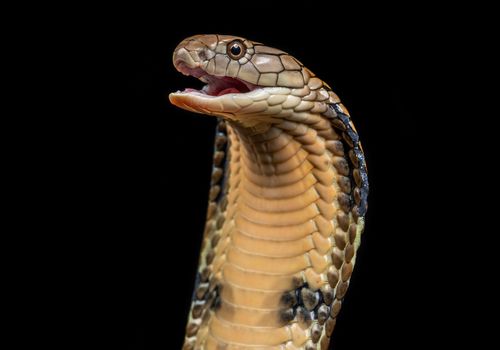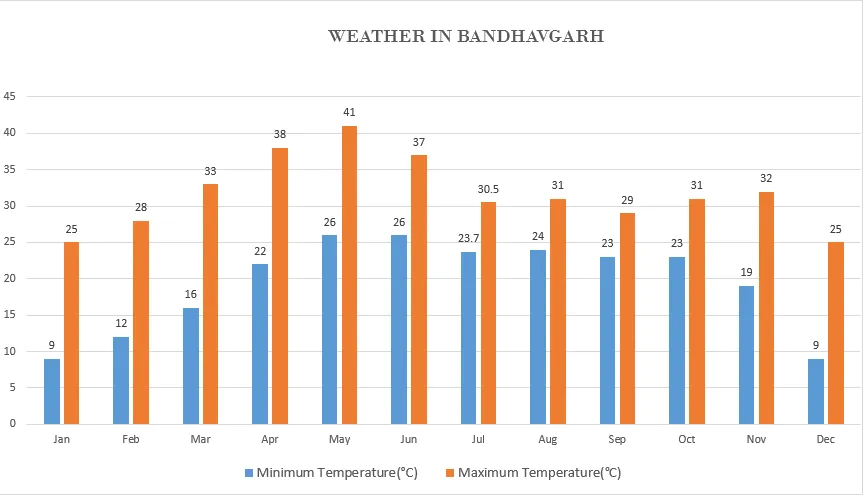Bandhavgarh National Park
Madhya Pradesh, India
About Bandhavgharh National Park
Bandhavgarh: Roar of the Jungle Kingdom.
Nestled in the heart of India, Bandhavgarh National Park beckons as a sanctuary of ecological wonder and mythological richness. Embark on captivating tiger safaris within the park’s lush expanse to witness its diverse wildlife. The park’s nomenclature, “Bandhavgarh,” originating from “Bandhav” (brother) and “Garh” (fort), narrates the tale of Brother’s Fort. According to ancient scriptures like Ramayana, Saint Valmiki’s verses hint at the park’s existence, believed to be a gift from Lord Rama to his brother Lakshmana.
Against the backdrop of the Vindhya ranges in the Tala Zone, the historic Bandhavgarh Fort stands proudly, serving as a testament to human endeavor and architectural finesse. Legends echo that the fort was reconstructed by two monkeys, who also crafted the famed bridge to Lanka from mainland India.
For nature enthusiasts, Bandhavgarh extends beyond tiger safaris, offering a gateway to India’s diverse wildlife. Explore the park’s verdant expanses for an enriching nature safari, complemented by opportunities for bird watching. Immerse yourself in the allure of this natural haven, linking your journey to broader narratives of nature safari in India, tiger safaris across the country, and the captivating world of bird watching in India.
Highlights
- Tiger safaris amidst India's pristine wilderness
- Rich biodiversity, including Royal Bengal Tigers.
- Mythological significance with Bandhavgarh Fort's history.
- Stunning Vindhya range landscapes.
- Abundant birdwatching opportunities.
- Historic Ramayana connections.
- Exciting wildlife encounters
- Conservation and natural beauty harmonized.
Once the stronghold of local rulers, Bandhavgarh became a Royal Hunting Reserve before conservation efforts. Maharajas aimed to kill 109 Tigers for auspicious reasons, with Maharaja Venkat Raman Singh even exceeding this number by 1914.
In 1947, Bandhavgarh came under the jurisdiction of Madhya Pradesh post-independence, but lax control allowed further forest degradation. However, a turning point came with Maharaja Martand Singh’s proposal. In 1968, a 105 sq km area was declared as the first National Park, transforming the conservation landscape.
With official recognition as a National Park, Bandhavgarh saw a significant reduction in poaching. Grazing was halted, and water holes were established, leading to a resurgence in the Tiger and wildlife population. In 1982, the park’s area expanded to 448 sq. km to accommodate the growing wildlife numbers.
In 1993, Bandhavgarh became a part of Project Tiger, and the park’s boundaries extended once again. The core zone encompassed 694 sq km, with a buffer zone of 437 sq km, collectively forming the Bandhavgarh Tiger Reserve.”
Facts about Bandhavgarh National Park
Area: 1161 sq. km- 624 sq. km is core and 537 sq. km is buffer forest.
Coordinates: 23 30’ 12 to 23 45’ 45 N to 80 47’15’’ to 81 11’ 45 E
Key Species of Bandhavgarh National Park

Mammals
- Tiger
- Leopard
- Jungle Cat
- Indian Wild Dog
- Jackal
- Sloth Bear
- Rhesus Macaque
- Sambar
- Barking Deer
- Wild Boar

Birds
- Painted Spurfowl
- Comb Duck
- Common Teal
- Malabar Pied Hornbill
- Lesser Whistling Duck
- Blue Bearded Bee Eater
- Pheasant Tailed Jacana
- Stork Billed Kingfisher
- Plum Headed Parakeet
- Yellow Crested Woodpecker

Reptiles
- Common Sand Boa
- Red Sand Boa
- Spectacled Cobra
- Green Keelback
- Buff Striped Keelback
- Dumeril’s Black Headed Snake.
- Common Krait
- Banded Krait
- Indian Rock Python
- Russell’s Viper
Safari Zones of Bandhavgarh National Park
Each park is categorized into three distinct zones: Core, Buffer, and Reserved. The Core zone serves as a sanctuary for the jungle’s natural state, preserving ecosystems found within the biosphere reserves. Here, the Forest Department enforces strict protection of wildlife and natural resources. The Buffer zone allows for the harmonious coexistence of animals and a portion of the human population. Lastly, the Reserved forest functions as a virtual boundary demarcating the forest’s limits. Despite these divisions, it’s essential to note that animals, being unaware of these “zones,” freely roam throughout their entire forest home.
In the case of Bandhavgarh, it boasts three Core zones: Tala, Maghdi, and Khitauli. Tala, as the oldest zone, is distinguished by its unique attractions, including Bandhavgarh Fort, Badi Gufa, Shesh Shaiya, and Chakradhara Hide. Maghdi and Khitauli, known as Gate no. 2 and Gate no. 3 respectively, offer exceptional Tiger sightings. With Tala witnessing a high volume of tourists, Maghdi and Khitauli provide a refreshing change, offering an entirely different perspective of Bandhavgarh. Tala offers breathtaking landscapes and picturesque views, while Maghdi and Khitauli immerse you in the authentic jungle experience.
Reaching Bandhavgarh National Park
Train
Getting to Bandhavgarh by train is a convenient option. There are train services to Umaria (37 kilometers away), Katni (100 kilometers away), and Jabalpur (180 kilometers away) Railway Stations from major cities across the country, such as Mumbai, New Delhi, Jaipur, Agra, Mathura, Gwalior, Bhopal, Sawai Madhopur, Hyderabad, Bengaluru, Chennai, and more. Once you reach one of these railway stations, you can easily drive to Bandhavgarh.
Flight
Bandhavgarh is a natural jungle without its own airstrip, but it enjoys excellent connectivity to cities within Madhya Pradesh that have airports. Jabalpur, located around 200 kilometers from the park, is well linked by air to major cities in India such as New Delhi and Mumbai.
Road
Bandhavgarh is conveniently linked to significant towns in Madhya Pradesh, accessible via both air and train travel.
Umaria: A quick 45-minute drive of just 37 kilometers connects you to Umaria, the nearest town to the park.
Jabalpur: A four-hour drive of approximately 190 kilometers will take you from Bandhavgarh to Jabalpur.
Katni: Katni is a two-hour drive away, at a distance of merely 100 kilometers from the park.
Weather and Clothing
- DO NOT carry shiny/bright colored clothing. Instead, carry earthy colors like shades of dull green or olive green, beige, and grey. Black is also avoidable as it attracts mosquitos.
- Carry comfortable, breathable clothes (cotton) in summer.
- Carry layers (4-5) of thin woolen clothes rather than one heavy jacket for winter. Layers are a lot more helpful through the varying temperatures during the day.
- Carry a wind cheater/rain coat just in case there is a light shower.
- Carry a Cap/Hat during summer.
- Avoid wearing strong perfume while on safari. Animals have a strong sense of smell and it may distract them

Enquire Now
Please fill the form below and our team will get back to you within 24 hours with a perfect tiger safari tour package.
FAQ
Bandhavgarh National Park, situated in the central Indian state of Madhya Pradesh, is a renowned and significant national park in India. It is nestled amidst the Vindhya mountain range and is known for its remarkable biodiversity and, most notably, its thriving tiger population. This park covers an area of approximately 450 square kilometers and is considered one of the prime tiger reserves in the country.
To experience a thrilling tiger safari in Bandhavgarh, visitors can book guided safaris offered by the park authorities. These safaris are typically available in two forms: jeep safaris and elephant safaris. The jeep safaris are more popular, providing a close and exciting encounter with the park’s diverse wildlife, including the majestic Bengal tigers. Visitors should secure permits and guides in advance to explore the park and increase their chances of spotting these magnificent big cats.
Bandhavgarh’s fame primarily stems from its high tiger density, making it one of the most reliable places to spot Bengal tigers in the wild. Its picturesque landscapes, encompassing lush forests and ancient fort ruins, also contribute to its allure. Moreover, Bandhavgarh is steeped in history and mythology, with the Bandhavgarh Fort, which dates back to over 2,000 years, adding a unique cultural dimension to the park’s attractions
Bandhavgarh National Park has a rich historical and cultural legacy. The park is home to the ancient Bandhavgarh Fort, believed to have been gifted by Lord Rama to his brother Lakshmana. The fort’s ruins, now a prominent feature in the park, are a testament to its historical significance. Bandhavgarh was also once the hunting grounds of the Maharajas of Rewa. In 1968, it was declared a national park to conserve its natural heritage, including its impressive tiger population.
Bandhavgarh is not only famous for its tigers but also boasts a diverse array of wildlife. Visitors can encounter leopards, sloth bears, Indian bison (gaur), sambar deer, barking deer, and various species of birds. The park is home to numerous species of flora and fauna, making it a rewarding destination for wildlife enthusiasts and nature lovers.
The best time to visit Bandhavgarh for a tiger safari is during the park’s opening season, which typically runs from October to June. The winter months, from November to February, are considered ideal for wildlife sightings as the animals are more active due to cooler temperatures. However, visitors should note that the park remains closed during the monsoon season from July to September.
Bandhavgarh National Park, like many national parks in India, actively participates in conservation efforts to protect its precious wildlife. The park implements strict regulations and guidelines to ensure the well-being of its resident tigers and other animals. Anti-poaching measures, habitat preservation, and community involvement are integral components of these conservation initiatives.
Yes, there are numerous accommodation options near Bandhavgarh National Park, catering to various budgets and preferences. Visitors can choose from luxury resorts, jungle lodges, and budget-friendly hotels. Staying near the park allows visitors to experience the natural beauty and wildlife of Bandhavgarh while enjoying modern amenities and comfortable lodging. It’s advisable to make reservations in advance, especially during the peak tourist season, to ensure a hassle-free stay.



